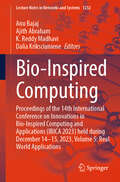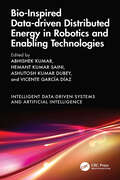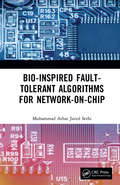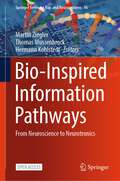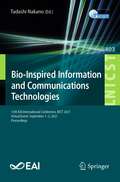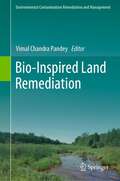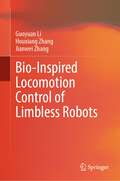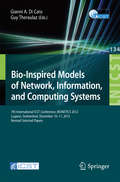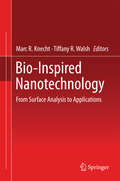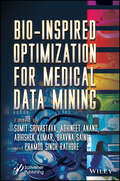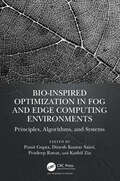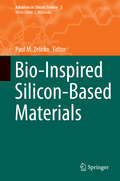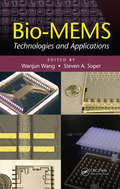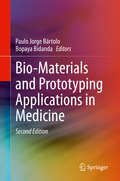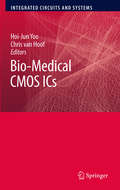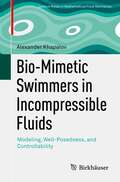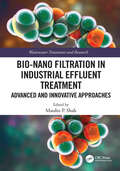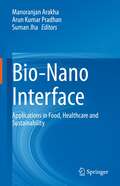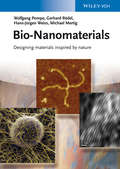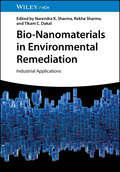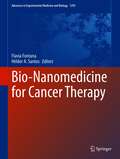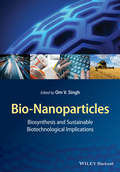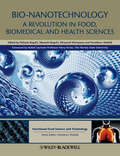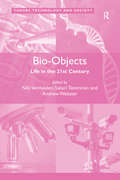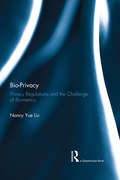- Table View
- List View
Bio-Inspired Computing: Proceedings of the 14th International Conference on Innovations in Bio-Inspired Computing and Applications (IBICA 2023) held during December 14-15, 2023, Volume 5: Real World Applications (Lecture Notes in Networks and Systems #1232)
by Ajith Abraham Dalia Kriksciuniene Anu Bajaj K. Reddy MadhaviThis book presents 53 selected papers focused on Machine Learning and Applications from the 14th International Conference on Innovations in Bio-Inspired Computing and Applications (IBICA 2023) and 13th World Congress on Information and Communication Technologies (WICT 2023), which was held in five different cities namely Olten, Switzerland; Porto, Portugal; Kaunas, Lithuania; Greater Noida, India; Kochi, India and in online mode. IBICA-WICT 2023 had contributions by authors from 36 countries. This book offers a valuable reference guide for all scientists, academicians, researchers, students, and practitioners focused on real-world applications of modern ICT and bio-inspired computing.
Bio-Inspired Data-driven Distributed Energy in Robotics and Enabling Technologies (Intelligent Data-Driven Systems and Artificial Intelligence)
by Abhishek Kumar Ashutosh Kumar Dubey Hemant Kumar Saini Vicente García-DíazThis book begins by introducing bio-inspired data-driven computation techniques, discussing bio-inspired swarm models, and highlighting the development of interactive bio-inspired energy harvesting systems to drive transportation infrastructure. It further covers important topics such as efficient control systems for distributed and hybrid renewable energy sources, and smart energy management systems for developing intelligent systems. This book: Presents data-driven intelligent heuristics for improving and advancing environmental sustainability in both eco-cities and smart cities. Discusses various efficient control systems for distributed and hybrid renewable energy sources and enhance the scope of smart energy management systems for developing even intelligent systems. Showcases how distributed energy systems improve the data-driven robots in the Internet of Medical Things. Highlights practical approaches to optimize power generation, reduce costs through efficient energy, and reduce greenhouse gas emissions to the possible minimum. Covers bio-inspired swarm models, smart data-driven sensing to combat environmental issues, and futuristic data-driven enabled schemes in blockchain-fog-cloud assisted medical eny ecosystem. The text is primarily written for graduate students, and academic researchers in diverse fiergelds including electrical engineering, electronics and communications engineering, computer science and engineering, and environmental engineering.
Bio-Inspired Fault-Tolerant Algorithms for Network-on-Chip
by Muhammad Athar SethiNetwork on Chip (NoC) addresses the communication requirement of different nodes on System on Chip. The bio-inspired algorithms improve the bandwidth utilization, maximize the throughput and reduce the end-to-end latency and inter-flit arrival time. This book exclusively presents in-depth information regarding bio-inspired algorithms solving real world problems focussing on fault-tolerant algorithms inspired by the biological brain and implemented on NoC. It further documents the bio-inspired algorithms in general and more specifically, in the design of NoC. It gives an exhaustive review and analysis of the NoC architectures developed during the last decade according to various parameters. Key Features: Covers bio-inspired solutions pertaining to Network-on-Chip (NoC) design solving real world examples Includes bio-inspired NoC fault-tolerant algorithms with detail coding examples Lists fault-tolerant algorithms with detailed examples Reviews basic concepts of NoC Discusses NoC architectures developed-to-date
Bio-Inspired Information Pathways: From Neuroscience to Neurotronics (Springer Series on Bio- and Neurosystems #16)
by Martin Ziegler Thomas Mussenbrock Hermann KohlstedtThis open access book offers a timely and comprehensive review of the field of neurotronics. Gathering cutting-edge contributions from neuroscientists, biologists, psychologists, as well as physicists, microelectronics engineers and information scientists, it gives extensive information on fundamental information pathways in selected nervous systems. It also highlights their relevance as building blocks for novel computing architectures, such as bio-inspired electronic devices, neuromorphic architectures, memristive devices, adaptive sensors and emergent, pulsed-coupled oscillatory networks. All in all, this book offers a unique bridge between fundamental research in neuroscience, neural information processing, nonlinear dynamics, and self-organization, and advanced practical applications concerning the fabrication of hardware-oriented computing.
Bio-Inspired Information and Communications Technologies: 13th EAI International Conference, BICT 2021, Virtual Event, September 1–2, 2021, Proceedings (Lecture Notes of the Institute for Computer Sciences, Social Informatics and Telecommunications Engineering #403)
by Tadashi NakanoThis book constitutes the refereed conference proceedings of the 13th International Conference on Bio-inspired Information and Communications Technologies, held in September 2021. Due to the safety concerns and travel restrictions caused by COVID-19, BICT 2021 took place online in a live stream. BICT 2021 aims to provide a world-leading and multidisciplinary venue for researchers and practitioners in diverse disciplines that seek the understanding of key principles, processes and mechanisms in biological systems and leverage those understandings to develop novel information and communications technologies (ICT). The 20 full and 2 short papers were carefully reviewed and selected from 47 submissions. The papers are organized thematically in tracks as follows: Bio-inspired network systems and applications; Bio-inspired information and communication; mathematical modelling and simulations of biological systems.
Bio-Inspired Land Remediation (Environmental Contamination Remediation and Management)
by Vimal Chandra PandeyLand is fundamental to the human life. The upper layer of land is a non-renewable resource, and source of food. Therefore, land health is essential to long-term food security and to promote sustainable livelihoods. On account of urbanization, industrialization and population growth, land pollution is one of the major issues worldwide. As a result, land pollution is continuing across the world, and has been linked with a wide range of potentially toxic contaminants at rates that deteriorate land quality. Land pollution can result either anthropogenic activities or natural activities. The major contaminants of land pollution are metalloids, petroleum hydrocarbon, radioactive elements, polyaromatic hydrocarbons (PAHs), Pesticide, other organic pollutants, etc. that comes from different types of sources. In urban and peri-urban areas, irrigation of agricultural land with polluted water is also a reason of land pollution. Therefore, land security is an important issue for future sustainability. Its remediation and management are important issue worldwide to protect land quality and functions. Land pollution means degradation of earth's surface. Polluted land comes under the category of degraded land. Hence, the remediation of polluted land is essential for regaining biodiversity and ecosystems services and thereby achieving United Nations-Sustainable Development Goals (UN-SDGs).This fact showed the need to develop research into land remediation. Bio-inspired land remediation has undergone a huge development. Therefore, Biomanagement has a lot of potential to secure upper earth’s surface through the land remediation programs targeted during the United Nations Decade on Ecosystem Restoration (2021-2030). This book explores the remediation of land pollution that includes Phytoremediation, Bioremediation (bacterial remediation and fungal remediation), Vermiremediation, Biochar-based remediation and other Bio-inspired remediation. This book will be a remarkable asset for research scholars, environmentalists, ecological scientist, agriculturist, practitioners, policy makers, entrepreneurs, and other stakeholders alike.
Bio-Inspired Locomotion Control of Limbless Robots
by Jianwei Zhang Guoyuan Li Houxiang ZhangThis book presents a bio-inspired hierarchical control scheme step by step toward developing limbless robots capable of 3D locomotion, fast reflex response, as well as sophisticated reaction to environmental stimuli. This interdisciplinary book introduces how to combine biological concept with locomotion control of limbless robots. The special features of the book include limbless locomotion classification and control, design of biological locomotor and the integration of sensory information into the locomotor using artificial intelligence methods, and on-site demonstrations of limbless locomotion in different scenarios. The book is suitable for readers with engineering background, especially for researchers focused on bio-inspired robots.
Bio-Inspired Models of Network, Information, and Computing Systems: 7th International ICST Conference, BIONETICS 2012, Lugano, Switzerland, December 10--11, 2012, Revised Selected Papers (Lecture Notes of the Institute for Computer Sciences, Social Informatics and Telecommunications Engineering #134)
by Gianni A. Di Caro Guy TheraulazThis book constitutes the thoroughly refereed post-conference proceedings of the 7th International Conference on Bio-Inspired Models of Network, Information and Computing Systems (Bionetics 2012), held in Lugano, Switzerland, in December 2012. The 23 revised full papers presented were carefully reviewed and selected from 40 submissions. They cover topics such as networking, robotics and neural networks, molecular scale and bioinformatics, optimization and bio-inspired modeling in various fields.
Bio-Inspired Nanotechnology: From Surface Analysis to Applications
by Marc R. Knecht Tiffany R. WalshThis book focuses on the use of bio-inspired and biomimetic methods for the fabrication and activation of nanomaterials. This includes studies concerning the binding of the biomolecules to the surface of inorganic structures, structure/function relationships of the final materials and extensive discussions on the final applications of such biomimetic materials in unique applications including energy harvesting/storage, biomedical diagnostics and materials assembly.
Bio-Inspired Optimization for Medical Data Mining
by Abhishek Kumar Sumit Srivastava Pramod Singh Rathore Abhineet Anand Bhavna SainiThis book is a comprehensive exploration of bio-inspired optimization techniques and their potential applications in healthcare. Bio-Inspired Optimization for Medical Data Mining is a groundbreaking book that delves into the convergence of nature’s ingenious algorithms and cutting-edge healthcare technology. Through a comprehensive exploration of state-of-the-art algorithms and practical case studies, readers gain unparalleled insights into optimizing medical data processing, enabling more precise diagnosis, optimizing treatment plans, and ultimately advancing the field of healthcare. Organized into 15 chapters, readers learn about the theoretical foundation of pragmatic implementation strategies and actionable advice. In addition, it addresses current developments in molecular subtyping and how they can enhance clinical care. By bridging the gap between cutting-edge technology and critical healthcare challenges, this book is a pivotal contribution, providing a roadmap for leveraging nature-inspired algorithms. In this book, the reader will discover Cutting-edge bio-inspired algorithms designed to optimize medical data processing, providing efficient and accurate solutions for complex healthcare challenges; How bio-inspired optimization can fine-tune diagnostic accuracy, leading to better patient outcomes and improved medical decision-making; How bio-inspired optimization propels healthcare into a new era, unlocking transformative solutions for medical data analysis; Practical insights and actionable advice on implementing bio-inspired optimization techniques and equipping effective real-world medical data scenarios; Compelling case studies illustrating how bio-inspired optimization has made a significant impact in the medical field, inspiring similar success stories. Audience This book is designed for a wide-ranging audience, including medical professionals, healthcare researchers, data scientists, and technology enthusiasts.
Bio-Inspired Optimization in Fog and Edge Computing Environments: Principles, Algorithms, and Systems
by Punit Gupta Dinesh Kumar Saini Pradeep Singh Rawat Kashif ZiaA new era of complexity science is emerging, in which nature- and bio-inspired principles are being applied to provide solutions. At the same time, the complexity of systems is increasing due to such models like the Internet of Things (IoT) and fog computing. Will complexity science, applying the principles of nature, be able to tackle the challenges posed by highly complex networked systems? Bio-Inspired Optimization in Fog and Edge Computing: Principles, Algorithms, and Systems is an attempt to answer this question. It presents innovative, bio-inspired solutions for fog and edge computing and highlights the role of machine learning and informatics. Nature- or biological-inspired techniques are successful tools to understand and analyze a collective behavior. As this book demonstrates, algorithms, and mechanisms of self-organization of complex natural systems have been used to solve optimization problems, particularly in complex systems that are adaptive, ever-evolving, and distributed in nature. The chapters look at ways of enhancingto enhance the performance of fog networks in real-world applications using nature-based optimization techniques. They discuss challenges and provide solutions to the concerns of security, privacy, and power consumption in cloud data center nodes and fog computing networks. The book also examines how: The existing fog and edge architecture is used to provide solutions to future challenges. A geographical information system (GIS) can be used with fog computing to help users in an urban region access prime healthcare. An optimization framework helps in cloud resource management. Fog computing can improve the quality, quantity, long-term viability, and cost-effectiveness in agricultural production. Virtualization can support fog computing, increase resources to be allocated, and be applied to different network layers. The combination of fog computing and IoT or cloud computing can help healthcare workers predict and analyze diseases in patients.
Bio-Inspired Silicon-Based Materials (Advances in Silicon Science #5)
by Paul M. ZeliskoThe contributed volume addresses a wide range of topics including, but not limited to, biotechnology, synthetic chemistry, polymer chemistry and materials chemistry. The book will serve as a specialized review of the field of biologically inspired silicon-based structures. Researchers studying biologically inspired silicon materials chemistry will find this volume invaluable.
Bio-MEMS: Technologies and Applications
by Wanjun Wang Steven A. SoperThis book considers both the unique characteristics of biological samples and the challenges of microscale engineering. Divided into three main sections, it first examines fabrication technologies using non-silicon processes, which are suitable for the materials more commonly used in medical/biological analyses. These include UV lithography, LIGA, nanoimprinting, and hot embossing. Attention then shifts to microfluidic components and sensing technologies for sample preparation, delivery, and analysis in microchannels and microchambers. The final section outlines various applications and systems at the leading edge of Bio-MEMS technology in a variety of areas such as drug delivery and proteomics.
Bio-Materials and Prototyping Applications in Medicine
by Paulo Jorge Bártolo Bopaya BidandaRapid prototyping is used to design and develop medical devices and instrumentation. This book details research in rapid prototyping of bio-materials for medical applications. It provides a wide variety of examples of medical applications using rapid prototyping, including tissue engineering, dental applications, and bone replacement. Coverage also discusses the emergence of computer aided design in the development of prosthetic devices.
Bio-Medical CMOS ICs (Integrated Circuits and Systems)
by Hoi-Jun Yoo Chris Van HoofThis book is based on a graduate course entitled, Ubiquitous Healthcare Circuits and Systems, that was given by one of the editors at his university. It includes an introduction and overview to the field of biomedical ICs and provides information on the current trends in research. The material focuses on the design of biomedical ICs rather than focusing on how to use prepared ICs.
Bio-Mimetic Swimmers in Incompressible Fluids: Modeling, Well-Posedness, and Controllability (Advances in Mathematical Fluid Mechanics)
by Alexander KhapalovThis monograph presents an original, concise mathematical theory for bio-mimetic swimmers in the framework of a coupled system of PDEs and ODEs. The authoritative research pioneered by the author serves as the basis for the method adopted here. This unique methodology consists of an original modelling approach, well-posedness results for the proposed models for swimmers, and a controllability theory that studies the steering potential of the proposed swimmers. A combination of this sort does not currently exist in the literature, making this an indispensable resource. Structured in five parts, the author establishes the main modeling approach in Part One. Part Two then presents the well-posedness results for these models. Parts Three through Five serve to develop a controllability theory for the swimmers, which are conceived of as artificial mechanical devices that imitate the swimming motion of fish, eels, frogs, and other aquatic creatures in nature. Several illustrative examples are provided in the last portion that serve as potential research topics. Bio-Mimetic Swimmers in Incompressible Fluids will appeal to graduate students and researchers studying fluid dynamics and control theory, as well as engineers interested in these areas.
Bio-Nano Filtration in Industrial Effluent Treatment: Advanced and Innovative Approaches (Wastewater Treatment and Research)
by Maulin P. ShahThe ever-increasing number of pollutants discharged into the environment drives the search for new treatment technologies or the modification of the existing ones. In this sense, innovation in bio-nano filtration systems seems very promising and, therefore, a book on the current advances and innovations on this topic is highly appropriate. Bio-nano filtration is a relatively new emerging technology applied to the treatment of wastewater and other toxic compounds. In the last two decades, this technology has begun to emerge as an economically viable process to treat the great variety of recalcitrant pollutants discharged into the environment. Thus, it is speculated that the US biofiltration market will reach over $100 million by 2020. This book aims to present how innovation in bio-nano filtration can provide effective solutions to overcome the serious problem of water pollution worldwide. The removal of contaminants will be the result of the combined effects of biological oxidation, adsorption, and filtration processes. Features: Describes the microbial ecology of bio-nano filtration. Describes the modelling of bio-nano filtration. Describes the design of bio-nanofillers.
Bio-Nano Interface: Applications in Food, Healthcare and Sustainability
by Manoranjan Arakha Suman Jha Arun Kumar PradhanThis book discusses the unique interactions of nanoparticles with various biomolecules under different environmental conditions. It describes the consequences of these interactions on other biological aspects like flora and fauna of the niche, cell proliferation, etc. The book provides information about the novel and eco-friendly nanoparticle synthesis methods, such as continuous synthesis of nanoparticles using microbial cells. Additionally, the book discusses nanoparticles' potential impact in different areas of biological sciences like food, medicine, agriculture, and the environment. Due to their advanced physicochemical properties, nanoparticles have revolutionized biomedical and pharmaceutical sciences. Inside the biological milieu, nanoparticles interact with different moieties to adopt stable shape, size, and surface functionalities and form nano-biomolecular complexes. The interaction pattern at the interface form complexes determines the fate of interacting biomolecules and nanoparticles inside the biological system. Understanding the interaction pattern at the nano-bio interface is crucial for the safe use of nanoparticles in natural sciences. This book rightly addresses all questions about the interaction and the ensuing structure and function of these nano-biomolecular complexes. This book caters to students and researchers in the area of biotechnology, microbiology, and pharmaceutical sciences.
Bio-Nanomaterials
by Hans-Jürgen Weiss Wolfgang Pompe Michael Mertig Gerhard RödelBio-nanotechnology covers the development of novel techniques and materials by making use ofthe inspiration derived from biomolecular structures and processes. The progress in molecular biology and microbiology over the past 50 years has provided a solid basis for such development.Well characterized natural biomolecules as well as tailored recombinant proteins and tailored microorganisms obtained by genetic engineering provide a large "toolbox" for the implementation ofbiological structures in a technical environment. Biologically inspired materials engineering enables,for example, the preparation of living tissue for regenerative bone therapy and the biologicallycontrolled mineralization of precious metal catalysts via immobilized microorganisms.Written by authors from different fields to reflect the interdisciplinary nature of the topic, thisbook guides the reader through novel nano-materials processing inspired by nature. The presentationis structured around general principles in seven chapters, each composed of three parts:(1) biological case studies providing the motivation, (2) elucidation of the particular principle,(3) applications related to materials processing.
Bio-Nanomaterials in Environmental Remediation: Industrial Applications
by Rekha Sharma Narendra K. Sharma Tikam C. DakalReference on using bio-nanomaterials to remove pollution in industrial sectors ranging from food and agriculture to oil and gas Bio-Nanomaterials in Environmental Remediation discusses the application of bio-nanomaterials in various industrial settings. Bio-Nanomaterials in Environmental Remediation includes information on: Fundamentals, classification, and applications of bio-nanomaterials, technologies for the fabrication of bio-nanomaterials, and desalination of wastewater using bio-nanomaterials Applications of bio-nanomaterials in the textiles, oil, gas, food, and agriculture industries Hazard, toxicity, and monitoring standards of bio-nanomaterials Current challenges of bio-nanomaterials in industrial applications and future outlooks in the field Strategies to manage the safety of bio-nanomaterials to enable the creation of healthy and pollution-free environments Bio-Nanomaterials in Environmental Remediation is an essential up-to-date reference for professionals, researchers, and scientists working in fields where bio-nanomaterials are used.
Bio-Nanomedicine for Cancer Therapy (Advances in Experimental Medicine and Biology #1295)
by Flavia Fontana Hélder A. SantosThe book covers the latest developments in biologically-inspired and derived nanomedicine for cancer therapy. The purpose of the book is to illustrate the significance of naturally-mimicking systems for enhancing the dose delivered to the tumor, to improve stability, and prolong the circulation time. Moreover, readers are presented with advanced materials such as adjuvants for immunostimulation in cancer vaccines. The book also provides a comprehensive overview of the current status of academic research. This is an ideal book for students, researchers, and professors working in nanotechnology, cancer, targeted drug delivery, controlled drug release, materials science, and biomaterials as well as companies developing cancer immunotherapy.
Bio-Nanoparticles
by Om V. SinghNanoparticles are considered to be the building blocks for nanotechnology and are referred to as the particles having more than one dimension of the order of 100 nm or less.The nanostructured materials are being offered as better built, long lasting, cleaner, safer, and smarter products for use in communications, medicine, transportation, agriculture and other industries. Topics in molecular recognition, biomolecule-nanocrystal conjugates as fluorescence label for biological cells, and DNA-mediated groupings of nanocrystals are widespread, intriguing researchers from both biological and engineering fields. The diversity of nanotechnology covers fields from biology to material science, physics to chemistry, and other fields with variety of specialties. Controlled size, shape, composition, crystallinity, and structure-dependent properties of nanoparticles govern the unique properties of nanotechnology. The controlled biosynthesis of nanoparticles is of high scientific and technological interest as the microorganisms grab target ions from their environment and then turn the metal ions into the element metal through enzymatic mechanism generated through their cellular (Intra/ Extra) activities. The project aims to introduce the basics and advancements made so far in the field of biosynthesis of nanoparticles for graduate students and researchers around the world. The main aims are to (a) introduce the reader to the variety of microorganisms and their ability to synthesize the nanoparticles, (b) provide an overview of the methodologies applied to biosynthesize the variety of nanoparticles of medical and commercial uses, (c) provide a literature review on diversity of microorganisms able to synthesize nanoparticles of different types, (d) to discuss the regulatory mechanisms in microorganism able to synthesize variety of nanoparticles, (e) discuss experimental design problems associated with the controlled biosynthesis of nanoparticles, (f) discuss the stability and toxicity of nanoparticles in varying environment towards their therapeutic implications. The regulations, challenges and implications of biosynthesized nanoparticles for commercial significance will also represent among the main sections of the book. These aims will be organized by invited research/ review articles from renowned researchers exploring biosynthesis of variety of nanoparticles, and differ in length and number of chapters, with the literature review section containing the bulk of the text.
Bio-Nanotechnology: A Revolution in Food, Biomedical and Health Sciences (Hui: Food Science and Technology #11)
by Fereidoon Shahidi Manashi Bagchi Hiroyoshi MoriyamaBio-nanotechnology is the key functional technology of the 21st century. It is a fusion of biology and nanotechnology based on the principles and chemical pathways of living organisms, and refers to the functional applications of biomolecules in nanotechnology. It encompasses the study, creation, and illumination of the connections between structural molecular biology, nutrition and nanotechnology, since the development of techniques of nanotechnology might be guided by studying the structure and function of the natural nano-molecules found in living cells. Biology offers a window into the most sophisticated collection of functional nanostructures that exists. This book is a comprehensive review of the state of the art in bio-nanotechnology with an emphasis on the diverse applications in food and nutrition sciences, biomedicine, agriculture and other fields. It describes in detail the currently available methods and contains numerous references to the primary literature, making this the perfect “field guide” for scientists who want to explore the fascinating world of bio-nanotechnology. Safety issues regarding these new technologies are examined in detail. The book is divided into nine sections – an introductory section, plus: Nanotechnology in nutrition and medicine Nanotechnology, health and food technology applications Nanotechnology and other versatile applications Nanomaterial manufacturing Applications of microscopy and magnetic resonance in nanotechnology Applications in enhancing bioavailability and controlling pathogens Safety, toxicology and regulatory aspects Future directions of bio-nanotechnology The book will be of interest to a diverse range of readers in industry, research and academia, including biologists, biochemists, food scientists, nutritionists and health professionals.
Bio-Objects: Life in the 21st Century (Theory, Technology and Society)
by Andrew Webster Sakari Tamminen Niki VermeulenIncreasing knowledge of the biological is fundamentally transforming what life itself means and where its boundaries lie. New developments in the biosciences - especially through the molecularisation of life - are (re)shaping healthcare and other aspects of our society. This cutting edge volume studies contemporary bio-objects, or the categories, materialities and processes that are central to the configuring of 'life' today, as they emerge, stabilize and circulate through society. Examining a variety of bio-objects in contexts beyond the laboratory, Bio-Objects: Life in the 21st Century explores new ways of thinking about how novel bio-objects enter contemporary life, analysing the manner in which, among others, the boundaries between human and animal, organic and non-organic, and being 'alive' and the suspension of living, are questioned, destabilised and in some cases re-established. Thematically organised around questions of changing boundaries; the governance and regulation of bio-objects; and changing social, economic and political relations, this book presents rich new case studies from Europe that will be of interest to scholars of science and technology studies, social theory, sociology and law.
Bio-Privacy: Privacy Regulations and the Challenge of Biometrics
by Nancy Yue LiuBio-Privacy: Privacy Regulations and the Challenge of Biometrics provides an in-depth consideration of the legal issues posed by the use of biometric technology. Focusing particularly on the relationship between the use of this technology and the protection of privacy, this book draws on material across a range of jurisdictions in order to explore several key questions. What are the privacy issues in the biometric context? How are these issues currently dealt with under the law? What principles are applied? Is the current regulation satisfactory? Is it applied consistently? And, more generally, what is the most appropriate way to deal with the legal implications of biometrics? Offering an analysis, and recommendations, with a view to securing adequate human rights and personal data protection, Bio-Privacy: Privacy Regulations and the Challenge of Biometrics will be an important reference point for those with interests in the tension between freedom and security.
